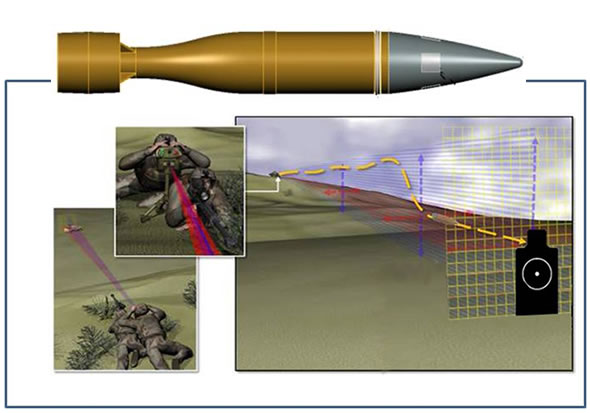July 29, 2013
The previous post got me to thinking about the importance (or lack thereof) of nomenclature in the assessment of warships and also how much aviation capability one might add to a surface combatant before one enters the zone of diminishing returns begins detracting from that ships mission.
This post over at CDR Salamanders got me to thinking about what the hell we might build to replace the FFG7s that's not the aluminum coffin that is the LCS.
As I have not slept much, these two thought resulted in this post...
The Oliver Hazard Perry class Frigates were much maligned in their day and are muh longed for in ours. They had a mediocre armament of a single standard missile launcher, a 3" gun forced on the navy by congress and 6 lightweight torpedo tubes. However they also had two helicopters and those, in combination with the ships hull mounted and towed sonars, made the vessel a formidable ASW craft, especially if operating in concert with one or more of her sisters. They also made the ship very useful for the peacetime roles the USN found itself required to play after the war everyone feared did not come to pass.
The were reliable, seaworthy andwere a bit faster than designed so they could be used with even the nuclear carriers in a pinch. USS Stark and USS Roberts proved the design could survive remarkable damage, though especially in the case of USS Stark the folly of using aluminum in the superstructure of a warship was relearned at great price.
These ships had little growth potential and were designed as cheap ships to pad out the numbers and complement the more expensive destroyers and cruisers.
Well they are at the end of their service lives now and the USN is replacing them with the Littoral Combat Ship.
Originally conceived as a corvette or fast attack craft with swappable mission modules and helicopter capability that could be built in great numbers due to its low cost, the LCS grew in cost to ludicrous proportions. It does have some some impressive characteristics though .
Firepower of Coast Guard Cutter,
Speed of cigarette boat,
Cost of European destroyer
Engines that keep on not working right, 5 YEARS after commissioning.
" Look Ma! NO SONAR! "
Fiendishly difficult to clean
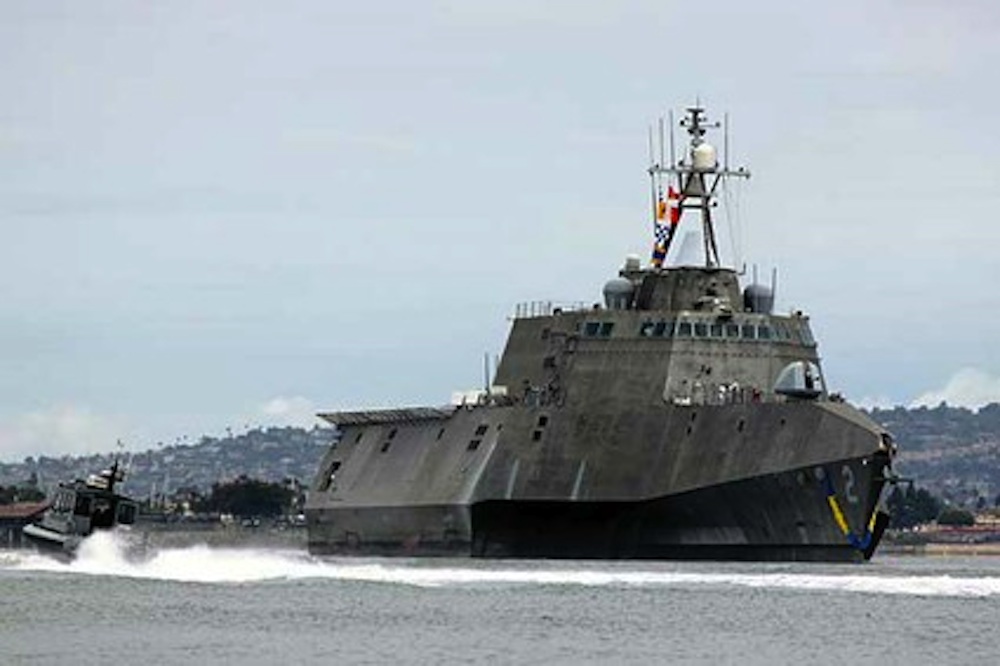
Of course, those characteristics tend to impress in the wrong way.
Additionally, there are two distinct classes because the navy couldn't decide which one sucked more and in fairness, both designs have their own unique shortcomings, (such as improperly fitted zincs) that they each bring to the table.
They do have two good points, particularly the trimaran design. They have very good aviation capability and a large working deck. However, no amount of tweaking is ever going to make them effective and especially not cost effective in ASW.
The navy needs numbers of ships, because a ship can only be in one place at a time. That is important for showing the flag and maintaining a presence in peacetime, it is even more so when dealing with submarines, and anti-submarine warfare is something that is becoming increasingly important as many navies acquire modern diesel electric submarines. The USA is a merchant republic and sea control and convoy protection are vital.
So whatever we buy to replace the LCS needs to be cheap enough to buy in numbers....during a decade we are likely to be very broke, with money left over after we spent it all on LCSs.
An all steel version of the OH Perry class might fit the bill, but adding a steel superstructure would require a complete redesign. We also need to remember that cost has to be kept down so only additional capability that can be had at minimal cost should be considered.
First off, what does an ASW vessel NEED?
Sonar (towed and hull)
Torpedo tubes
Helicopters.
4 helicopters are the absolute minimum for maintaining one helicopter on station at all times so 5 seems like a good number if we can get it. But could one carry 5 helos on a frigate/destroyer sized hull?
Well, some years ago the German shipyard Bremer Vulkan put forth an idea for a helicopter capable Offshore Patrol Vessel. Here is a screencap of their brochure

There is a sketch of a 6000 ton vessel in the same design series but no brochure available.

AAA systems needs a fire control system, and here is where these things go off the rails cost wise. I'd keep it very austere, though the low end SPY-1K of the aegis system (designed for corvettes) might be acceptable and could leverage existing logistics and training..
No ABM capability for this ship, just point defense and the limited area defense that ESSM implies. Minimal ECM would be carried.
The above vessel is fitted with a French 100mm gun, but the brochure indicates that guns of up to 5 inches are doable, and indeed the MK 45 was designed with ships as small as 600 tons in mind. Putting one on the bow would help keep people from thinking of the ship as a carrier (which it most assuredly is not) and provide it with the useful gun the OHPs and LCS lack. For surface combat, a few Harpoon or NSM perhaps re-loadable from the ships magazines would be adequate.
(Spanish frigates carry 60 lightweight and heavyweight torpedoes so this ship should be able to carry 100 or more lightweight torpedo sized weapons)
Steel is cheap in comparison to electronics so if we can keep from going overboard on electronics and use an off the shelf propulsion plant we should get a decent ASW platform, that is very adaptable for peacetime duties that costs quite a bit less than what we are building now.
Posted by: The Brickmuppet at
06:08 PM
| Comments (1)
| Add Comment
Post contains 1169 words, total size 9 kb.
In the Late 1950's and early1960s the Japanese began seriously rebuilding their navy Maritime Self Defense Force. The reason for this was that although war as an instrument of policy was forbidden to them by their postwar constitution, the reality is that Japan imports most of its calories and virtually all of its energy and resources. Defense of the sea lanes was vital as was the ability to fend off invaders from certain of Japan's neighbors that defined "peace" as an absence of non-communist nations.
To this end, Japan began producing destroyers for antisubmarine warfare, that is convoy protection of Japans sea lanes. This is a purely defensive operation well within the purview of Japans constitutional restrictions on its military self defense forces. The 1950s destroyers carried fearsome torpedo batteries, but these were seen in the context of coastal defense and convoy defense, particularly with long range ASW torpedoes.
By the early '60s though, the concept of heavyweight ASW torpedoes was looking less tenable. The US and Australia were developing rocket boosted torpedoes and the Canadians, French and Italians were looking at big ASW Helicopters, which could do many of the things the US Blimps had done in WW2 but had much shorter range.
The Japanese decided to go with both options, buying ASROC from the US and developing the American Sea King as an ASW platform. The Sea King was a huge chopper, and to be effective, at least one (preferably 2) needed to be on station around a convoy, dropping sonar buoys and dipping their big sonar at any time. However helicopters have very short legs and the Sea King is awkward to handle on a small ship*. For destroyers the Japanese joined with the Americans in producing an ultimately abortive small torpedo carrying drone but this was no substitute for the capabilities of the Sea King.
To this end the Japanese ordered an experimental small helicopter carrier as part of the same procurement program as their prototype guided missile destroyer Amatsukaze. I've found very little on this ship. It reportedly was to have been about 10,000 tons and armed with 8 3" 50 caliber guns and 8-10 Sea Kings. As such it would seem to be a purely defensive ship with next to no capability to do anything except guard Japans sea lanes...it also would have been exceedingly useful in that role and made Japanese convoy defense operations vastly more effective. Japan was looking at 4-6 escort groups each built around one of these vessels.
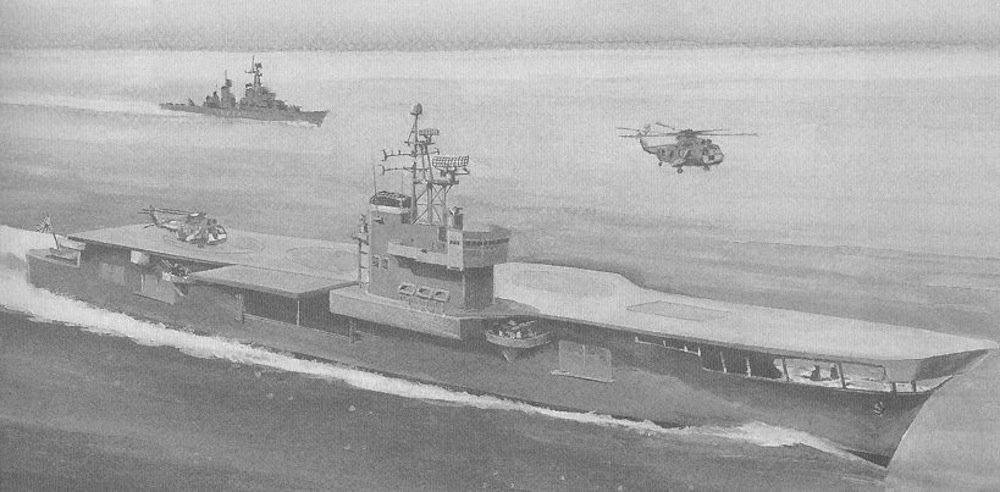

However experience has shown that three helicopters is insufficient to keep even 1 on station at all times. There is also the need for a large seaworthy vessel to operate helicopters in high sea states and convoy defense requires a certain amount of command and control space beyond that of an escort. An escort carrier is precisely what Japan need. It's too bad they can't have any carriers isn't it ?
In a COMPLETELY unrelated development. Japan has begun replacing it's large helicopter capable destroyers of the Haruna and Shirane classes with the somewhat larger 'destroyers' of the Hyuga class. These carry an official complement of 4 big helicopters in a VERY spacious hanger that can accommodate 16 or more in a pinch. Of course, as the JMSDF has explained to the legislature, these ships have a phased array radar and a battery of between 40 and 64 guided missiles (depending on which missile types are carried in their 16 missile tubes) so they are totally destroyers.
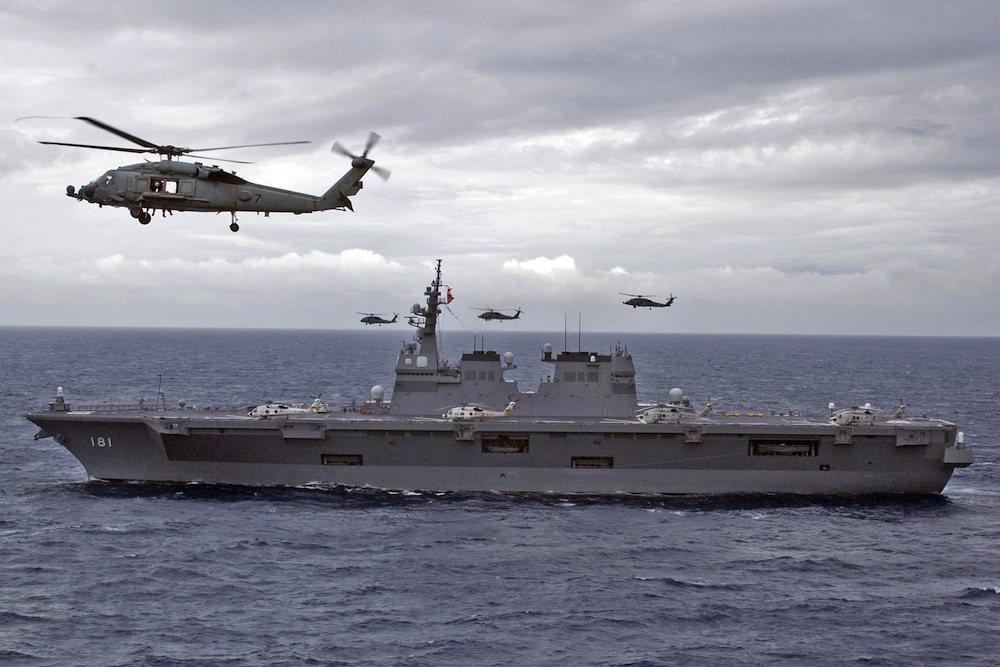
Though far larger and more capable than the proposed carrier of the 1960s these destroyers nevertheless are only a stopgap design. Since Japan cannot possess aircraft carriers the country needs to build the very best destroyers it can get as compensation. Thus the next class designated "22DDH" will be a bit larger....Actually they'll be about 19,000 tons standard and 27,000 tons fully loaded. That's about the size of a Yorktown class aircraft carrier.
Here she is drawn to scale with JDS Hyuga...
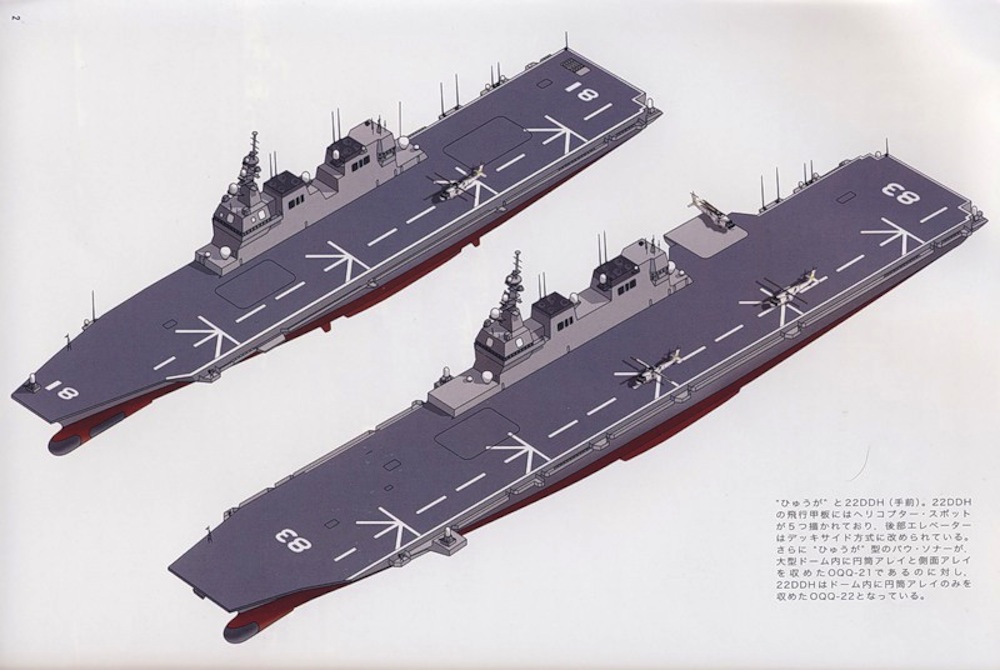
...and here the new ship is seen in comparison to three historical Japanese ships: Akagi, Shokaku and Kaga.
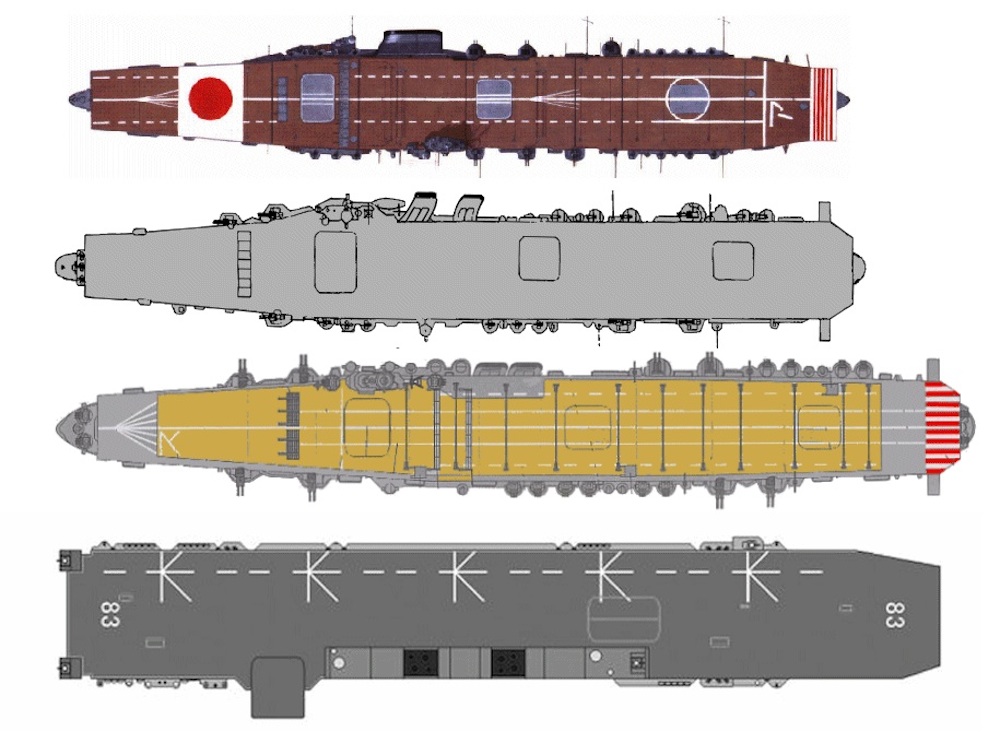
These ships will have, in addition to their missile batteries, 7 ASW helicopters in a VERY spacious hangar. In fact the hangar is about the size of that on an early Essex class carrier. The ship will also carry several 'search and rescue aircraft'. This SAR wing will consist of V-22 Ospreys. However, according to some sources, it will also include F-35 Bs which no doubt will bring a smile to many a stranded mariner as they drop life rafts from their bomb bays rescue equipment compartments. (I'm a bit skeptical of the F-35 reports, if only because the whole F-35 program is in disarray). The ships will also be able to carry a very large number of Ground Self Defense troops for disaster relief. This is a useful capability as Japan is prone to disasters such as volcanoes, earthquakes, tsunami's, typhoons and Chinese nationals on the Senkakus
27,000 tons might seem large for a destroyer but that's the kind of inefficiency one gets when one decides to put a bunch of helicopters on a destroyer.
It's just a terrible terrible shame that the Japanese can't have any carriers.
*don't tell the Canadians that though.
Posted by: The Brickmuppet at
11:49 AM
| Comments (7)
| Add Comment
Post contains 973 words, total size 7 kb.
July 02, 2013
Does Sydney NEED rebuilding?

More here:
At least 150 pre-fabricated skyscrapers from Central Station to Strathfield, conveyor belts shuttling building materials above Ultimo, train lines ripped up for new ones underground, and much of the steel and concrete shipped from China, with an army of international workers assembling it all for a pittance.
The novel project could have been Sydney's had the O'Farrell government been just a bit more expansive in its thinking.
Perhaps instead of 'more expansive' 'less prudent' would be a more appropriate descriptor in that last sentence.
I've noted this tactic from China before, most notably in places like Columbo and their 'string of pearls' , but also in The Canal zone, Bahamas and San Diego.
I'm sure that none of those places will find they have listening devices, basic facilities for naval bases or changes in contract terms at any point in the future. No sirreee.
Full disclosure: That last paragraph is a combination of sarcasm, paranoia and vigilance in uncertain proportions.
Posted by: The Brickmuppet at
09:00 PM
| Comments (5)
| Add Comment
Post contains 181 words, total size 2 kb.
April 09, 2013
Huntington Ingalls is offering a development of their San Antonio Class LPD this time for Ballistic Missile Defense.
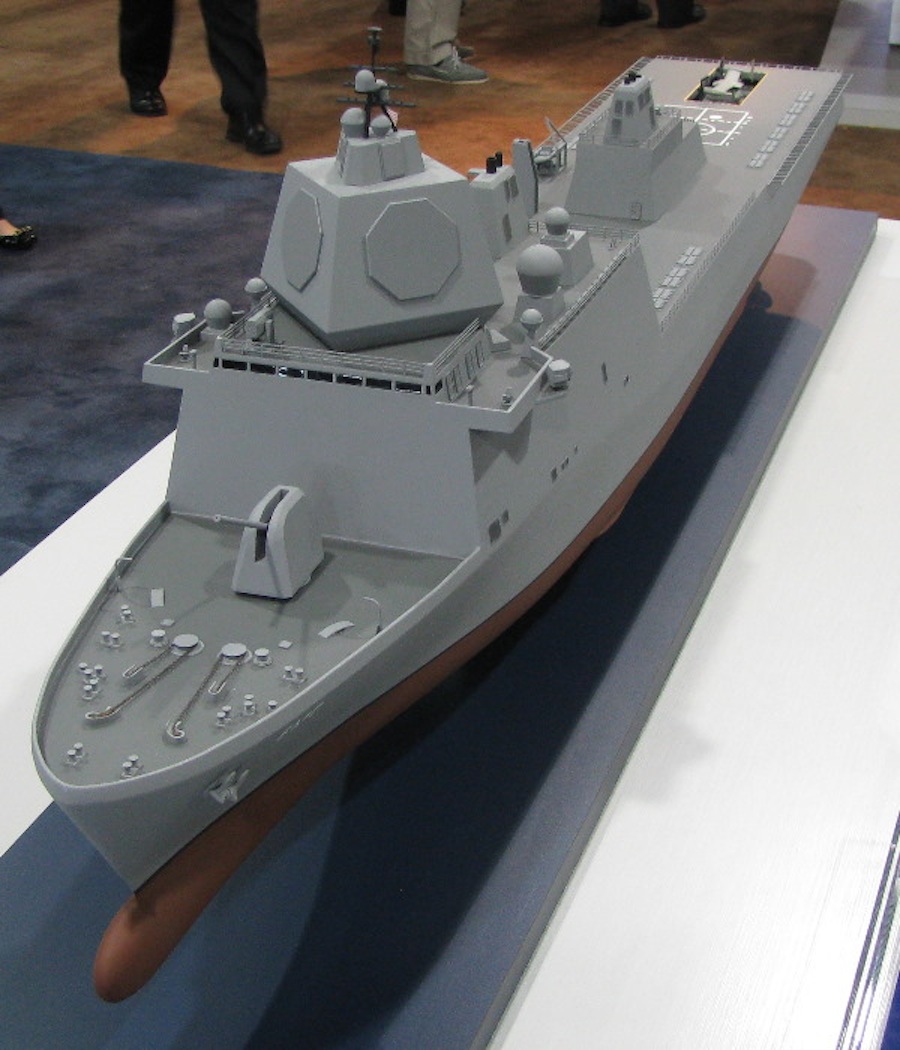
However, the hull itself is built to full military specifications and, after over a decade of tweaking has had all the bugs worked out.
So: there is this large, perfectly serviceable, already designed hull with VAST amounts of volume available (if one removes the well dock, marines and tanks) and it is designed for survivability.
We need ships to replace the Ticonderoga class cruisers which are at the end of their lives. Any such replacement is going to need a much bigger radar system than the Aegis to retain full Anti Ballistic Missile capability into the future.
Ingalls has responded by taking the off the shelf LPD-17 hull and removing the extensive cargo and troop handling facilities as well as the damage control nightmare that is the drydock. Thus the ship is made structurally simpler and probably much tougher. They then slapped a big AMDR radar, 288 mk 57missile tubes, a hangar and flight deck for V-22s some 57mm cannons and a notational railgun mount.
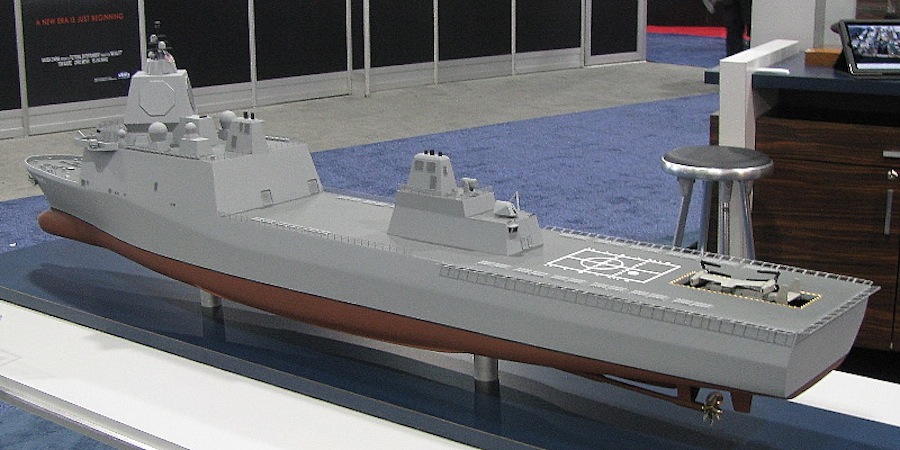
I'd think moving the hangar spaces above deck athwart the funnels would be better than to rely on a single elevator. But I'm paranoid that way.
The navy seems unimpressed:
The Navy, however, has started focusing on developing ships that could carry out multiple missions rather than singular mission vessels, a notion it promotes with the Littoral Combat Ships, which are designed to carry swappable missions packages for surface warfare, anti-submarine warfare and mine countermeasures.
"We have to get away from building single missions ships,†Vice Adm. Tom Copeman, the commander of Naval Surface Forces and Pacific Fleet, told an audience at SNA.
This criticism seems blinkered. And not just in it's use of the term LCS as something other than a punch line or an epithet.
The hangar, the 57s and the big arse gun show this to be a multipurpose vessel. Railguns and helicopters do not contribute to BDM. Additionally, the large "empty" space amidships that in LPD 17 is used for vehicle ramps would seem to lend itself to something of the sort of C-4I facilities that the Navy only has on the two remaining (quite elderly) command ships. This last is entirely speculative, but some sort of expanded flagship facilities are sorely needed in the USN. (**but see update)
The big question mark is speed. No speed is given for the above ship though most other offerings in the family move at 20-24 kts. The USN considers about 30 to be frontline*. Note that speed/power curves go up fast around 24 knots. While it's possible that enough power can be crammed in to boost the ship 6 to 8 knots, it seems unlikely without regiggering the hull.
Nevertheless, even assuming a speed around 23kts, a large vessel optimized for extended economical cruising is just what is needed for ABM patrols. The fact that this vessel can do other missions, is perfectly capable of keeping up with the Amphibious ships, is off the shelf, steel hulled and relatively roomy would seem to be a very very useful bit of kit that could be obtained for minimal risk and expense compared to it's capability.
*The Brits determined during WW2 that a sustained speed of 23 knts was the minimum adequate for escorting fast carriers, but that was before nuclear carriers and in any event the USN generally requires 28-30 kts for front line vessels to keep up with the CBGs.
**UPDATE: It seems that they have a flagship version already designed to replace the Blue Ridge class along with several other auxiliaries. . This doesn't mean that extra C&C space is unwelcome of course.
Posted by: The Brickmuppet at
04:36 PM
| Comments (3)
| Add Comment
Post contains 721 words, total size 6 kb.
March 30, 2013
About a year ago, the glorious Gun-Nuts at Forgotten Weapons got hold of an actual, honest to gawd EM-2.
For those unaware, the EM-2 was a British Assault Rifle designed in the late 1940s that took into account all the 'lessons learned' from World War 2. The rifle had design input from Poles who had had the unpleasant experience of tangling with the German 'storm guns'. It was a bullpup, which made it very compact and had something akin to an ACOG sight. The gun was designed around a new 7mm round that was intermediate in power between the very heavy 7.62mm and the varmint sized 5.56mm NATO rounds. In other words exactly what the lessons from current unpleasantness in Asia would seem to indicate is ideal.
In tests, the rifle wiped the floor with US, Belgian, French and Swedish weapons besting even the FN-FAL in reliability and accuracy.
It was adopted by the UK but was withdrawn in part because the US ignored the tests and forced NATO to adopt the .308 Winchester round (as 7.62 NATO)*. The Belgian gun was better suited to the larger round and was also much cheaper to manufacture so the EM-2 never enterd full production and only saw very limited use in Burma and Malaya before it was consigned to the dustbin of history.
What I did not know was that there was actually a small lot of EM-2 rifles made in 7.62 NATO....and here one is, courtesy of the Forgotten Weapons crowd.
That's AWESOME! I want one of those shooty culverts in MY basement.
Also: I want a basement.
With so much of our kit worn out after a decade of fighting we could do far worse than dusting off this old UK design. In fact, we probably will.
*this is somewhat ironic. In the 1920s and 30s the US Army had determined the best rifle/machine gun round would have ballistics nearly identical to the 7mm British, and in fact officially adopted the .276 Pedersen for the M-1 Garand. However the financial crunch of the Depression meant that the army had to make due with the obsolete .30-06 round, the Garand was re-chambered and the lessons learned were, it seems, lost. With hindsight it seems that the Springfield armory of the 30's and Enfield in the 'late '40s were both completely right.
Posted by: The Brickmuppet at
09:30 PM
| Comments (1)
| Add Comment
Post contains 436 words, total size 3 kb.
March 29, 2013
OK, so the North Koreans, as part of their perpetual saber rattling have released a picture of Kim El Porker and his junta sidekicks studiously planing a strike on the US with missile trajectories mapped out on the wall behind him.
First off those are not the most efficient or realistic courses for a missile. It looks like someone drew them without taking into account the Mercator distortion. In actuality, a ballistic tragectory from North Korea would, on a Mercator plot appear to arc north. It would pass over Alaska and possibly the arctic circle (for the same reason that flying to Japan from the US frequently involves a trip over pack ice).
That aside....The targets are Pearl Harbor, Los Angeles, Washington DC and...ummm...Austin.

WHY WOULD YOU WASTE ONE OF YOUR 4 NUKES ON AUSTIN?
It's an eclectic and neat town, but depriving the nation of a cool art scene and dinner theater does not seem to have the strategic benefits of, say, wiping out San Diego or the SSBN base near Tacoma.
I see 3 possibilities:
1: It's a cunning ruse, intended to trick us into moving our ABMs to Austin.
2:The Norks, being lefties, just HAETS them some Texans and aimed at the capital, not realizing that Austin is...well...Austin.
3: They are going to use the nuke to mutate the bats, turning them into giant flappy, fire-breathing, blood-sucking horrors that will terrorize the continent and lead to the collapse of the US.
Ubu, Avatar. We need your perspectives on this.
Posted by: The Brickmuppet at
08:17 PM
| Comments (5)
| Add Comment
Post contains 254 words, total size 2 kb.
January 09, 2013
The USN has a crying need for a low end patrol vessel.
Numbers are necessary because, despite advances in technology. A ship can only be in one place at once. It might be able to use aircraft and small boats to expand its immediate area of influence, but this does not actually reduce the need for numbers ships to be in disparate locations at the same time in order to do the various low end things that navy's and coast guards do.
Showing the flag, hunting pirates, intel gathering, Search and Rescue, disaster relief law enforcement do not require Aegis Destroyers or Cruisers and it is a waste of those valuable resources to dedicate them to such missions, and in any event sufficient numbers of such capital ships cannot be afforded.
Lots of low end ships are needed and the LCS is far too expensive to buy in numbers, particularly in the current financial crisis.
Meanwhile, in France.
DCN has come up with a family of warships called the GOWIND.
The baseline vessel is an OPV. One prototype, the FS Adroit, has been built and has been extensively tested by the French Navy. Adroit is a very austere vessel of 800 tons but it has some interesting features.
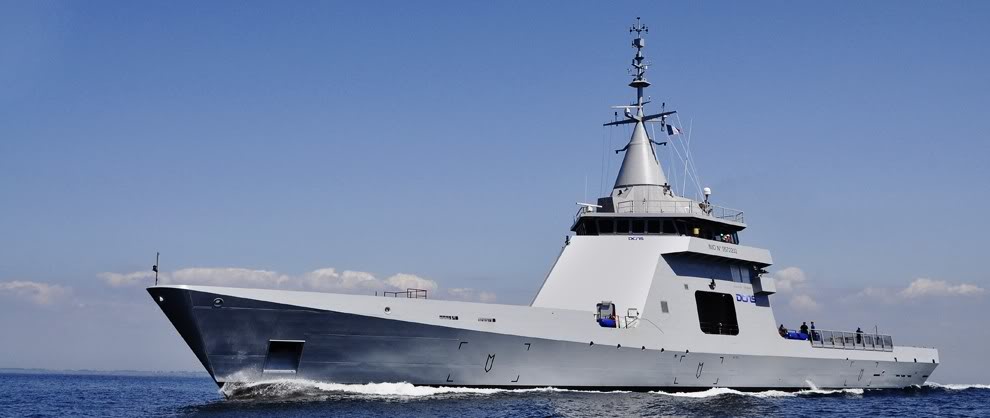
Adroit has a helicopter deck that can take a 12 ton helicopter (the size of an EH-101 or an S-92 and a hanger under the bridge and between the uptakes that can take a small helicopter like a Dolphin or a Seasprite and one or two drones.
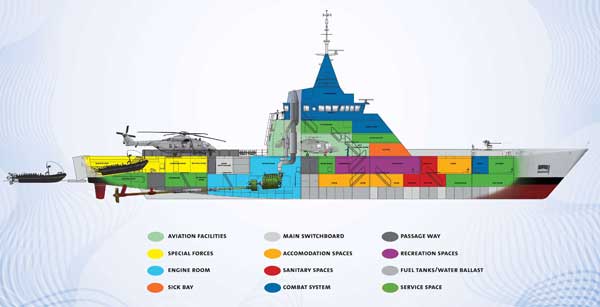
It it currently only armed with a 20mm cannon, but it has hard points for an OTO Melera Super Rapid 76mm gun, 8 Exocet SSMs and a 12 cell (Wikipedia says 16 cell) launcher for ASTER 15 point defense missiles.
These are all comparable to, and except for the Exocets, larger than, the equivalent USN weapons which are the 57mm Bofors, Harpoon and the short MK 41 vls for ESSM. (There is a new ultra compact 36 cell ESSM launcher that appears on the Huntington Ingalls patrol frigate proposal that looks to be even smaller but no hard data is forthcoming.)
The French ship is slow; only 21 kts, but it uses the same power that its 400 ton predecessor used to attain 22. It is very hydro-dynamically efficient and has a range of 8000NM. The hull form is designed to be scaled up for much faster speeds in high end versions so higher powered engines might get the speed up to 24 kts at some cost in endurance.
It is seaworthy too. The French offered the vessel to South Africa and pitched it by the straightforward method of sailing Adroit to Cape Town and having the ship bob about and do operational things in the Southern Ocean, which, due to it's infinite fetch, sports some of the most hellish sea conditions on the planet.
The ship can be operated ( in theory) by around 30 personnel due in part to its very low maintenance commercial engines. However it has accommodation for 60, which the French have found is quite fortuitous as continuous boardings require multiple boarding parties. The ships fire control system is designed to cope with its wartime weapons fit. It is fitted with communications gear allowing it to integrate into a NATO task force as well. There is no mention of its EW fit but I have to assume it is very austere.
The Adroit would seem to be an exceedingly good fit for the US Coast Guard since it offers comparable capability to the medium endurance cutters with much better seaworthiness and range at a low enough cost that large numbers can be built. It only needs a 57mm gun and some crew served weapons as far a armament, but it comes ready to be upgraded with bolt on missiles to a slow corvette in time of war. A towed array would give it the ability to act as a sonar tug and Lily-pad for Navy Seahawks and a Seasprite replacing the Dolphin in the hangar would make it a very decent second line ASW ship in a major war. It's quite slow, but the Navy might buy a few to pad out numbers. It can keep up with the 'Gator Navy' or a convoy and can show the flag and look good doing it.
The French, having proven the concept have a variety of evolutionary developments in the pipeline up to full-on 30 kt frigates. They've recently sold 6 of an uprated version to Malaysia . This is a full fledged Corvette with 28 kt speed, full sized hangar, real superstructure and a more extensive weapons & sensor fit. The contract for 6 corvettes is US $2.6 billion which works out to a bit over 433 million apiece for vessels rather more capable that the LCS. With a range of 5000 NM its practically a small frigate.
 This would seem to be a good replacement for the Perrys and rather a step up from either LCS design.
This would seem to be a good replacement for the Perrys and rather a step up from either LCS design.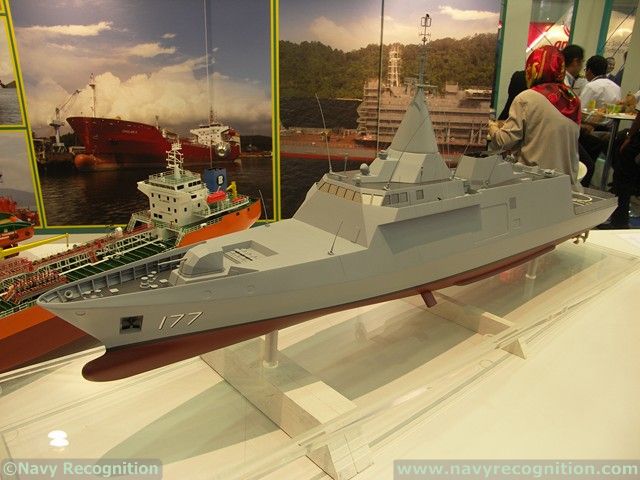

One thing this can't do very well, is mine warfare. For that specialized mission, a development of the current wooden sweepers, which do work, might be a better fit.
There are legal and political issues to buying foreign designs, (though these don't apply as much to the CG). However, the existence of these vessels shows what is possible. This evolutionary approach of building on proven designs still works, as the French are proving. It is something the USN needs to get back to.
Posted by: The Brickmuppet at
10:51 PM
| Comments (2)
| Add Comment
Post contains 923 words, total size 8 kb.
January 01, 2013
...that we closed down Charleston, Staten Island and Roosevelt Roads so that we can have 9 carriers in one spot for an ice-cream social?
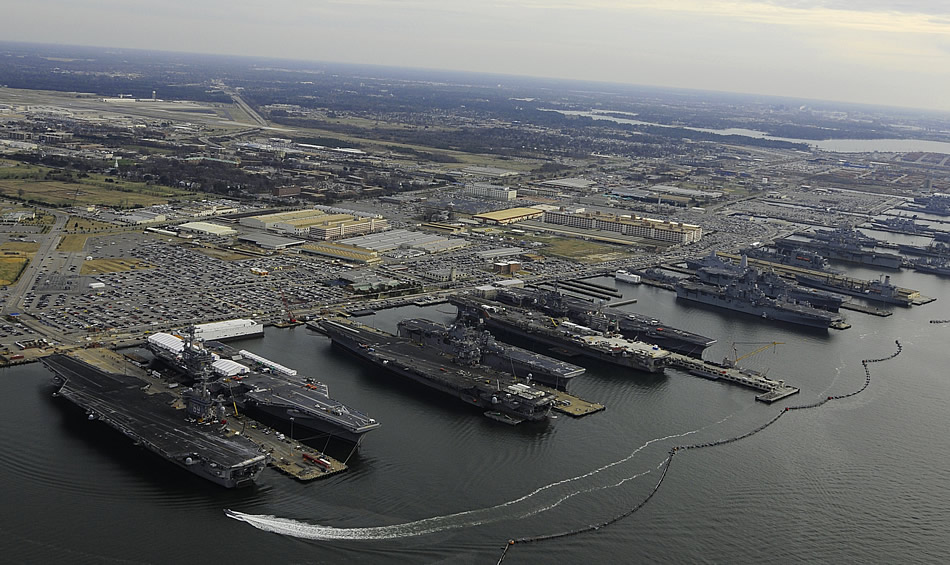
Posted by: The Brickmuppet at
08:25 PM
| Comments (8)
| Add Comment
Post contains 103 words, total size 1 kb.
November 21, 2012
I suspect that there is a story here....
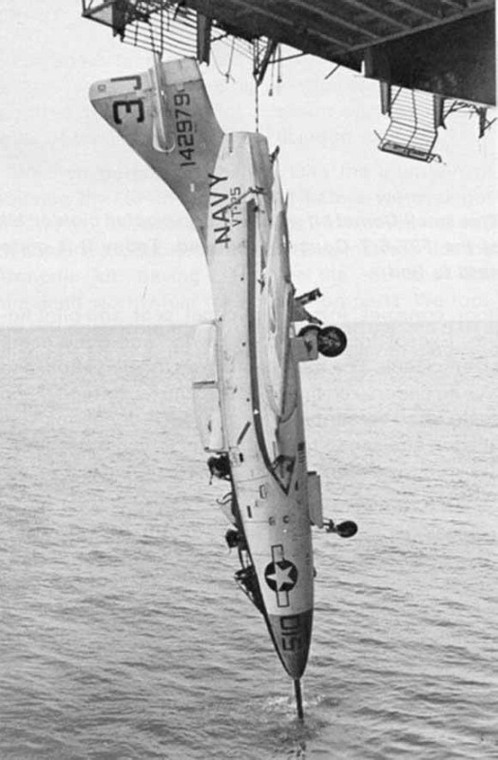
Posted by: The Brickmuppet at
10:44 PM
| Comments (6)
| Add Comment
Post contains 19 words, total size 1 kb.
June 04, 2012
"Sea Hake Mod4"apparently.*
... At a test-firing in March 2012, the heavyweight torpedo SeaHake mod4 ER (Extended Range) achieved a range of over 140 kilometres.
Note that 140 clicks = 86.92 statute miles

While it might take an hour to reach its target area a salvo of these things could generate an awfully large area of surprise 'torpedo water'....but unlike say the Battle of Tassafaronga, the torpedo water would be full of homing weapons. Yikes!
This massively complicates the defense of our warships.
On the bright side, this looks like a viable excuse for...TORPEDO Pr0n!
Posted by: The Brickmuppet at
09:49 AM
| Comments (2)
| Add Comment
Post contains 173 words, total size 2 kb.
May 28, 2012
For the longest time I thought that one of the reasons that US kit was so expensive is because we insisted on producing the components here where its much more expensive rather than overseas.
Silly me...
Now it looks like at least some computer chips used in US Military hardware have Chinese installed back doors in them. via

Posted by: The Brickmuppet at
03:41 AM
| No Comments
| Add Comment
Post contains 59 words, total size 1 kb.
May 16, 2012
General Dynamics has announced a new machine gun at the current NDIA conference. It's an interesting weapon, weighing in at just over 3 pounds less than the army's current 7.62 mm machine gun the M-240B. However, it's about a pound heavier than the recently fielded M-240 L (lightweight). Its overall length is slightly longer and it's rate of fire is slower.
Oh, and it's chambered for .338 caliber (8.58mm).


Anthony G. Williams has some thoughts.2
I’ve just been examing the gun at NDIA and talking to the GD people there (including the ammo designer, Jimmie Sloan). The gun isn’t based on the FN MAG / M240, it’s actually based on the .50 cal XM806. It uses the same soft-recoil technology, in that the gun fires as the barrel group is moving forwards. This smoothes out the recoil dramatically, allowing the gun to weigh about the same as the M240 (24 lbs) and to use a lightweight tripod. I’ve been watching a video of it firing and it doesn’t move – most impressive.
The 338NM was chosen to keep the length down with long, heavy bullets. The loading used for the MG is a 300 grain FMJ at 2,650 fps.
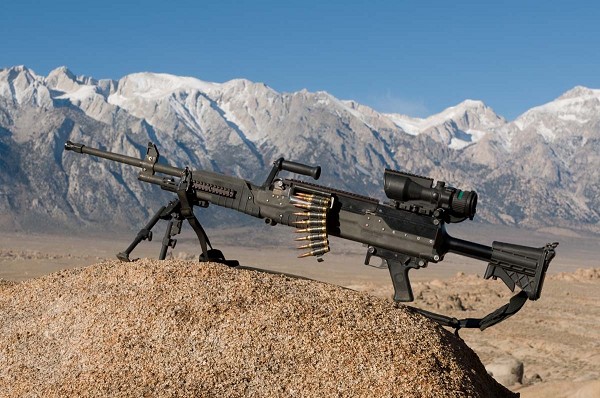

- .338 Norma Magnum
- 24 Pounds
- 49 inches
- 500 rounds per minute
- .338 Norma Magnum
- 300gr Sierra HPBT, FMJ, AP
- Muzzle Velocity 2650 FPS
- 24 inch barrel
- 1700 meters effective range
- 5642 meters maximum range
- uses M192 tripod
There's more at the Firearm Blog and on Anthony Williams forum.
Posted by: The Brickmuppet at
02:41 PM
| Comments (2)
| Add Comment
Post contains 369 words, total size 4 kb.
December 07, 2011
...the fleet was sunk when caught unawares by a well planned sneak attack that came in two waves.
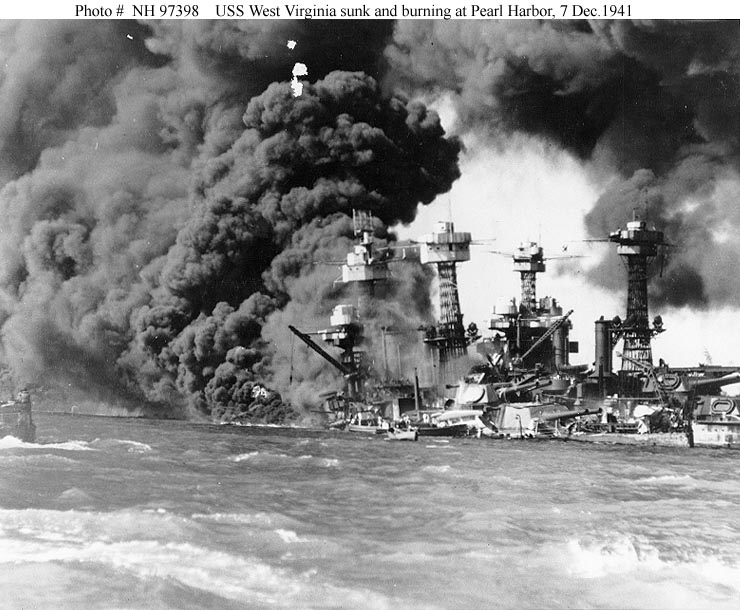
Soon the entire navy may be gutted, in two waves. Not only are numbers set to plummet due to austerity, but the ability to to maintain and replace any fleet may be eliminated by CBO ineptitude.
Which is the greater infamy?
Posted by: The Brickmuppet at
01:32 AM
| No Comments
| Add Comment
Post contains 62 words, total size 1 kb.
November 17, 2011
EXACTO is a guided a missile intended to be launched from guns and be interchaingable with existing ordinance increasing weapon accuracy and reducing the chance of collateral damage.. This is not at first blush in any way unusual. However, the guns in question are not 155mm weapons nor 105's.
EXACTO is to be launched from 12.7mm barrels.
No that decimal did not slip.
Fifty.
Caliber.
Guided.
Missile.
Posted by: The Brickmuppet at
03:04 AM
| Comments (2)
| Add Comment
Post contains 76 words, total size 1 kb.
July 24, 2011
Shipyard prices are skyrocketing. The number of shipyards is dropping.
As the navy is getting old and worn out ships are being laid up. Meanwhile, it seems that the ships the USN are procuring are being delivered 'pre-worn' so the bluejackets can skip the whole step of sailing them around before laying them up.
The waterjets of the LCS have fallen out due to galvanic corrosion, apparently because the shipbuilders didn't use zincs properly.
LPD 17 San Antonio has never worked right and appears to be a pier ornament now. Much of the issue there seems to stem from faulty welds which are contaminating the lube oil with metal shavings.
This story from my local paper is not strictly a manufacturing issue but speaks to massive incompetence in shipbuilding procurement. (We couldn't have used them as tenders...used them as SOMETHING?)

These problems are deep and systemic. There are no quick solutions. However we may be able to at least move in the right direction. There are two historical parallels that we can use as examples.
In the1880s the UK was extracating itself from Afganistan and was facing some financial difficulties. At the same time the UKs shipbuilding program was terribly screwed up, with problems that included cost overruns, excessively long build times, ships massively over budget as well as overdue, quality control issues, problems integrating new technologies and simple corruption (sound familiar?). The response was to, for a time, order only second line vessels such as gunboats and auxiliaries as well as a few experimental technology test beds such as experimental high speed craft (the torpedo boats).
These were often ordered outside the usual defense procurement clique. (eleventy)
In the meantime the procurement system was overhauled, investment was made in physical plant improvements at the shipyards and the procurement system was reformed, Concurrently, a determination of what sort of vessels were needed was made. Then rational, attainable requirements for the various types of vessels were drawn up that matched the then current technologies, the national strategy of the time as well as the gamut of potential scenarios.
After several years of building gunboats and finishing the dubious vessels that were already ordered, the Royal Navy began building ships under the Naval Defence Act. William Whites design team produced the finest ships that had been built up to that time and for nearly two decades, every subsequent class was an improvement on their design predecessor in some way.
In the late 1920's the US Navy changed the design of its cruisers drastically, switching the emphasis from underwater protection to protection against shellfire. However, cruiser size was strictly constrained to 10,000 tons by the Washington Naval Treaty. Cramming all that extra armor needed to resist 8" shellfire and still come in under the legal weight pushed the state of the art to the limit. The commercial shipyards balked and quoted prices that were exceedingly high. The Navy built the first New Orleans class cruisers in Navy Yards. This allowed the Navy to learn by doing the tricks to the new technologies and give commercial shipyards some training in those fields. This also gave USN officers a LOT of hands on experience in shipbuilding which was invaluble for both quality control inspections and giving a holistic view of damage control. Both stood the USN in good stead in WW2.
There are legal problems with this today as the government shipyards are not allowed to compete with commercial yards in procurement. However, Navy yards are still important in a wartime situation so it is beneficial to have them engage in some shipbuilding to keep their skills sharp. The abysmal performance of the commercial yards in such basic fields as welding and cathodic protection indicates that some remedial training is needed. Shipyards are a national asset. This is nova panacea and ought to be done as a very small percentage of a total procurement, but it has worked in the past.
On the flip side of this is a lack of competition. Government regulators like a few big companies because they are easy to regulate and control and they don't innovate much so bureaucrats don't have to face their own inadequacies. A handful of businesses make it easy to form cartels and grease beauraucratic palms.
We actually have a fair number of shipyards in the country but very few of them get involved in major defense procurement in part because cost plus contracting requires a byzantine army of accountants and lawyers that is larger than the total staff of some of these shipyards. This not only promotes corruption and cost padding, it is a huge barrier to entry for new firms...which isalmost certainlyone of the motivations. Get rid of cost plus and you get rid of several problems at once.
The lager problems involve planning, requirements and overall design. There needs to be something to dissuade crazy ideas like aluminum hulled frigate sized tenders that cost as much as European destroyers carrying the armaments of a coast guard cutter at...50 knots. That would require something like the old General Board...but that's a topic for another time.
Posted by: The Brickmuppet at
02:05 PM
| Comments (4)
| Add Comment
Post contains 878 words, total size 7 kb.
October 29, 2009
JS Kurama, a Japanese Shirane class helicopter destroyer, has collided with a Korean container ship in the narrow Kanmon strait between Kita-Kyushu and Shimonoseki. (H/T: Information Dissemination)
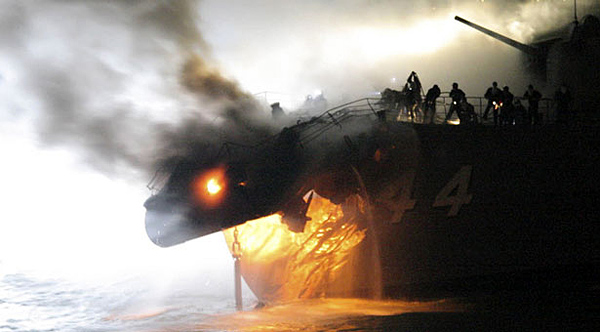
This is why we do those drills. (Pic via)
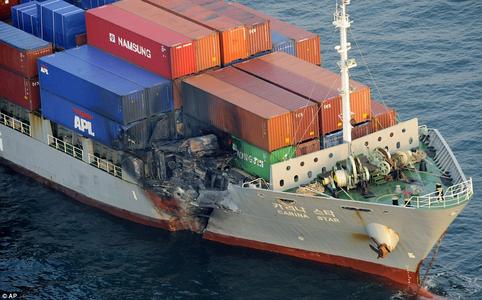
It is unclear how much of the damage was due to the collision vs the fire, but if paint thinner in sufficient quantity had a steady supply of air then the fire could have easily reached blast furnace temperatures. With the close proximity of the 5 inch magazines and the sheer intensity of the fire, the fact that the ship is pier-side rather than on the bottom is a testament to her damage control team.
.
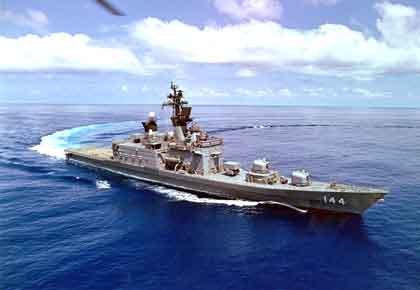
Damage control is vital and this requires DC teams. This brings up a related point that our staffing gurus need to be beat over the head with.
A warship is designed to go into harms way, which generally refers to threats greater than a merchant ship. A warship needs to be able to fight while hurt and have enough crew to do damage control while others are fighting the enemy. The number of personell to do this must take into account those killed by the weapons that caused the damage. Given the difficulties that current staffing policies cause in rather benign conditions, "optimal manning"....isn't.
Posted by: The Brickmuppet at
07:28 PM
| Comments (1)
| Add Comment
Post contains 363 words, total size 4 kb.
September 28, 2009
Over at Information Dissemination there is a long and detailed post on the logistical implications of the presidents decision to switch from ground based to sea based Ballistic Missile Defense for Europe, which I touched on briefly here.
There is a LOT involved. It may require as much as 16 ships. I still think it was a defensible decision given the options but it certainly is not a cheap one. Read the whole thing. There is a good discussion in the comments too.
Posted by: The Brickmuppet at
10:13 PM
| No Comments
| Add Comment
Post contains 86 words, total size 1 kb.
September 22, 2009
Technical and life issues have kept me from blogging for a while but the decision of the current administration to abandon a ground based missile defense of Eastern Europe is still garnering considerable comment, most of it quite partisan, very little of it thoughtful.
A modern president is generally not afforded the luxury of having available clear cut good and bad decisions particularly on foreign policy. None of these decisions take place in a vacuum and there are always other considerations and ramifications that interact like the workings of a pachinko machine except that they often result in deaths. Like Bush before him, President Obama is quite often presented with no good options available and like Bush, he is faced with the unenviable task of trying to select the least bad option from a truly vile lot.
I am certainly no fan or booster of the current president but think that a good case can be made that the decision in this case was in the national interest, in good faith and possibly the least bad available. Here is why.
Recent events in Afganistan and particularly Pakistan highlight the absolute necessity of not relying solely on a logistics line that runs through the Indus valley. However, options are limited by geography.

As I understand it, the facts facing the Obama administration were these:
A:The Russians desperately want to have a visible foreign policy victory for reasons of national prestige and credibility both foreign and domestic. They have railed against the placing of US missile defense systems in Poland. Although this is largely a symbolic thing it tasks them considerably.While we tend to think of this issue in terms of the brutal and wicked oppression the USSR inflicted upon its client states ( not to mention its own people) the Russians concern with foreigners on their frontier is based on a thousand years of slavic blood spilt by invaders.
B: While it has had some recent successes, and can likely be made to work, the US ground based BMD system has had a very chequrered development.
C: The US naval BMD system has not. (Interestingly, it was developed as an evolutionary outgrowth of the Aegis system almost as an afterthought, and was quite outside of the court intrigues and political power games of the land based system.) While on paper a less capable system, it has proven to be spectacularly successful with a demonstrated capability to not only hit incoming warheads but knock down low flying satellites as well. This system is operational.
D: The range of the system is such that if USN aegis vessels just...you know....happened to be stationed in the Black, Baltic and Adriatic Seas they could provide a decent umbrella against an Iranian Ballistic Missile attack.
Keeping ships on station in those areas is well within the capabilities of the USN even without any homeporting in Gdańsk and Varna...which might well be offered.
Thus by conceding the land based system and replacing it with BMD Aegis the US keeps its word in deed if not word to the nations it promised protection to. The Russians get something they want...a diplomatic victory. However, this doesn't really hurt the US tangibly.
This might seem like more unilateral self flagellation and concessions ....typical Obama kowtowing. It's not like we have gotten any major concessions from Russ....Oh WAIT*!! NATO can now resupply via Russia and this specifically includes using NATO aircraft in Russian airspace. This is a non trivial consession if there ever was one.
This had the potential to be the rarest of all things, a win, win win, in foreign policy, where nobody actually looses. The only thing that might screw it up would be if we made the announcement that we were yielding to the Russians and breaking the letter of our word to Eastern Europe...on...I don't know....the ANNIVERSARY OF THE INVASION OF POLAND BY GERMANY AND RUSSIA.
Dear GOD! The Stupid BURNS.
Ahem.....
I don't know about my fellow righties, but I did not spend half a year last year saying "Country first!" because it was a catchy little ditty. We need to support the president when he does something right.... at least the parts he doesn't utterly screw up with unfathomably wretched timing. Given Obama's fairly provincial and left wing background there is always going to be something for us to cringe at in abject horror on issues foreign and domestic. But, knee jerk attacks on delicate foreign policy maneuvers in a time of war is not a good idea.
At the very least we ought to reserve judgment until after we have some better handle on how the President is going to respond to McChrystals' request.
Am I off base?
Tilt away in the comments please.
* Hat Tip Information Dissemination
Posted by: The Brickmuppet at
07:27 PM
| Comments (1)
| Add Comment
Post contains 935 words, total size 7 kb.
August 16, 2009
Eaglespeak has been covering the mystery of the MV Arctic Sea for several days now.
Cliffs Notes version: The Moter Vessel Arctic Sea, a Maltese ship with a Russian crew was siezed by pirates posing as marine police in the...BALTIC SEA. After transiting into the Atlantic all the vessels transponders wee shut off...no one knows where the ship is. Though there have been at least 2 reported sightings one just last night, both are a bit sketchy at best.
See here here and here. There is a bit of analysis at Information Dissemination here.
Posted by: The Brickmuppet at
04:55 AM
| Comments (1)
| Add Comment
Post contains 99 words, total size 1 kb.
August 08, 2009
Over at The Marine Forum there is a very large collection of pictures from the 2008 Euronavale, a European defense contractor convention with a naval focus.
A few trends are visible, and others have commented upon some of them at length. The poster/photographer at MF was obviously drawn to the frontline ship offerings, in the distance there seem to be a lot of OPVs and similar vessels.
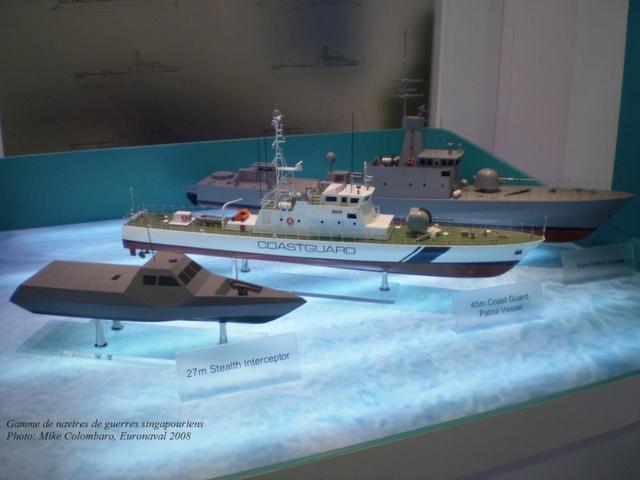
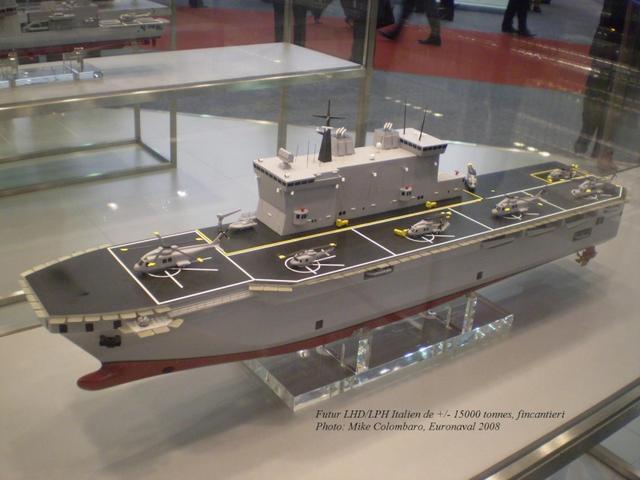
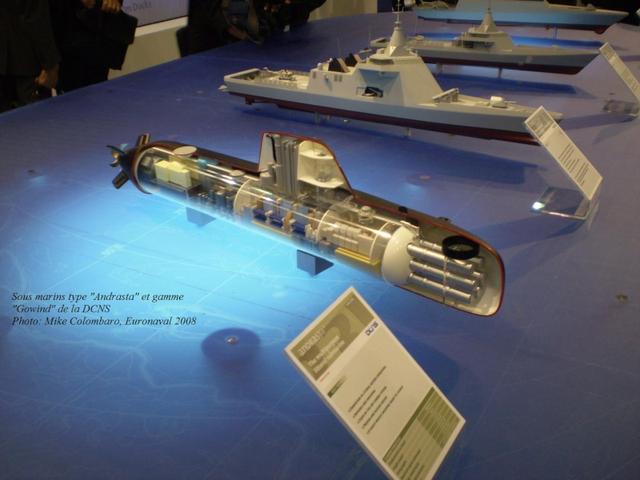
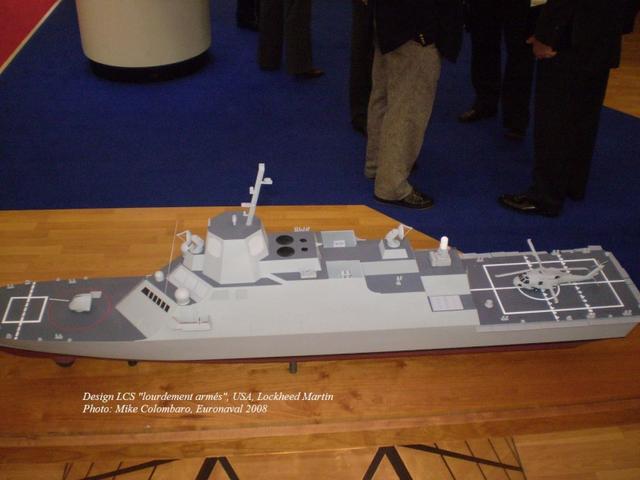
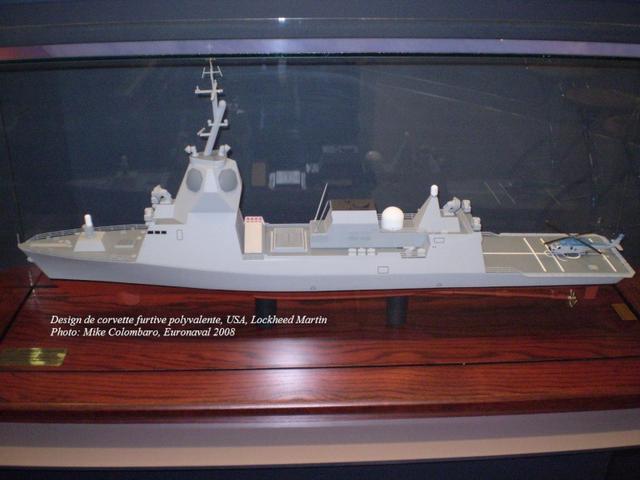
There are several export designs from US firms particularly LockMart which is not only offering yet another aegis equipped export version of their LCS (this time retaining the 57mm gun) but also an Aegis corvette that may be aimed at an Israeli requirement. Then there is this...
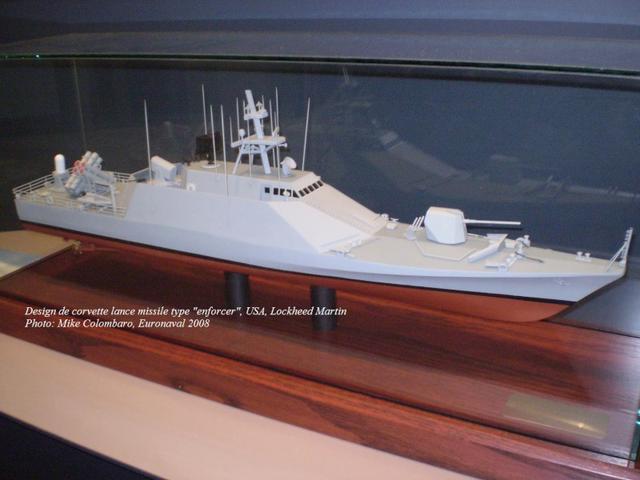
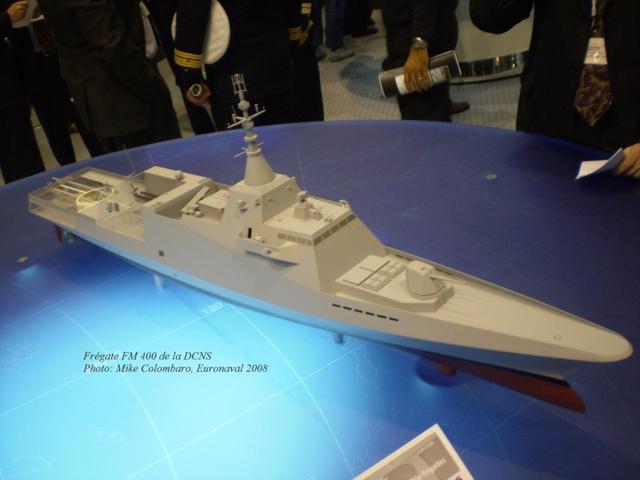
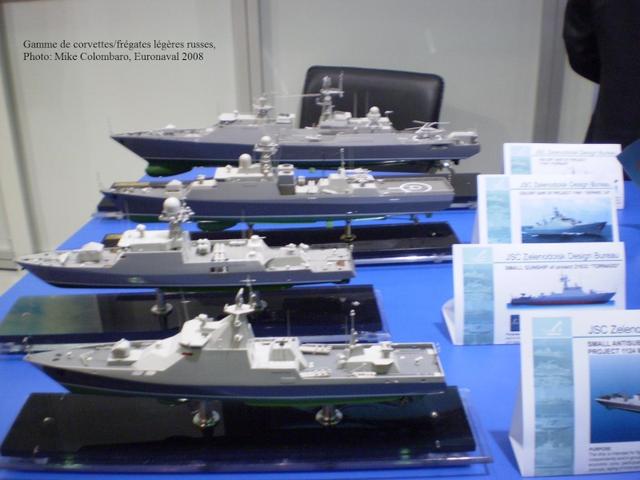
The natural predator of the small costal surface warship is an aircraft but SAMs might make this untenable in some circumstances. So the guns may be a hedge as well as being potentially usefull against small boat swarms,
One other thing needs to be mentioned, though it is not a trend...behold the solar powered Offshore Patrol Vessel (with force projection capability!)
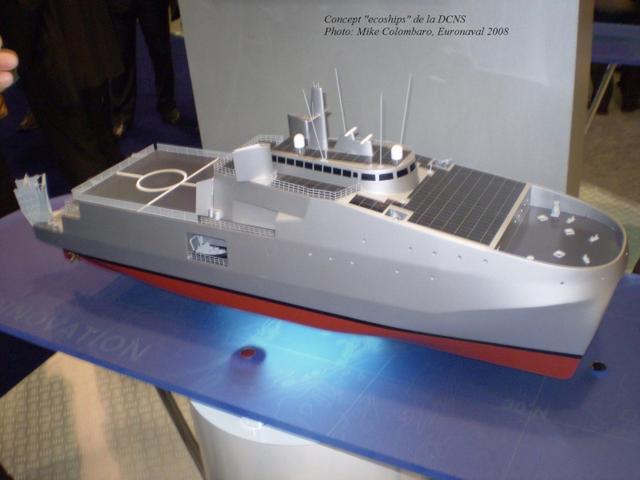
Anyway...discuss.
Posted by: The Brickmuppet at
04:16 PM
| No Comments
| Add Comment
Post contains 442 words, total size 4 kb.
81 queries taking 1.8536 seconds, 296 records returned.
Powered by Minx 1.1.6c-pink.









